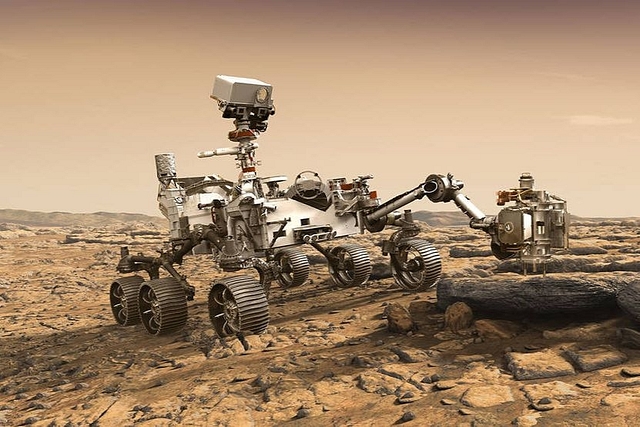
NASA’s Test Device On Perseverance Rover Successfully Turns Carbon Dioxide Into Oxygen On Mars
MOXIE drew carbon dioxide from the Martian atmosphere to produce its first oxygen on 20 April.
After a successful flight on Mars by National Aeronautics and Space Administration’s (NASA's) Ingenuity helicopter, the space agency said that for the first time its Perseverance rover successfully converted some carbon dioxide from the Martian atmosphere into pure, breathable oxygen.
Space Technology Mission Directorate (STMD) associate administrator Jim Reuter said in a statement: "This is a critical first step at converting carbon dioxide to oxygen on Mars”.
The task was accomplished by a toaster-size, experimental instrument aboard Perseverance called the Mars Oxygen In-Situ Resource Utilization Experiment or MOXIE.
This device drew carbon dioxide from the Martian atmosphere to produce its first oxygen on 20 April.
According to the American space agency, after an hour of operation, MOXIE produced about 5.4 gram oxygen.
Even though the amount is small, it is enough to keep an astronaut healthy for 10 minutes. The successful production of oxygen also proves that the technology works on the red planet.
MOXIE is designed to produce up to 10 grams of oxygen in an hour.
Future Possibilities
Mars has 95 per cent carbon dioxide, 2.6 per cent molecular nitrogen, 1.9 per cent argon, 0.16 per cent oxygen and 0.06 per cent carbon monoxide.
So, the red planet is controlled by greenhouse gas. But now scientists know how to convert it to oxygen.
It is good news as this recent finding could pave the way for future human exploration programmes to Mars.
Oxygen takes up a lot of room on a spacecraft. So, it is very unlikely that astronauts will be able to carry enough oxygen while travelling from Earth to Mars.
This means that the future Mars mission crew will need to produce their own oxygen from the Martian atmosphere, for breathing, as well as for fuelling rockets to return to Earth.
MOXIE descendants ultimately could generate enough oxygen — around 25 metric tonnes — to launch four astronauts off Mars.
Producing this amount of oxygen on-site would save a lot of weight, space, fuel and money for the initial journey to the red planet.
Even in the distant future, if humans are sent to set up a colony on Mars, this first-generation oxygen generator would be the best option to live on the red planet.
Reuter said that MOXIE has more work to do but the results from this technology demonstration are full of promise as NASA moves towards the goal of “one day seeing humans on Mars".
However, MOXIE is an experiment that is not related to the primary science mission of Perseverance.
While the rover's major role is to find rock samples and send them back to Earth, MOXIE is focused on the engineering needs of exploration pursuits.
Over the next two years, MOXIE is expected to extract oxygen from the ultra-thin atmosphere on Mars at least nine more times.
Future operations will test its abilities at different times of the day and across the seasons on the red planet.
The device is capable of drawing in the air with the help of a pump. It uses heat and electrical currents to separate oxygen atoms from carbon dioxide molecule, which are made up of one carbon atom and two oxygen atoms.
The oxygen atoms quickly combine into O2 molecules — oxygen that we breathe on Earth. During the process, it also generates carbon monoxide as a byproduct.
However, converting Martian greenhouse gas into oxygen is not the only way that future astronauts could survive on Mars.
Experts have proposed the idea of using on-site rocks to build structures, digging up Martian ice to produce drinking water or rocket fuel.
But MOXIE’s success has given NASA the initial confidence for future Mars missions.